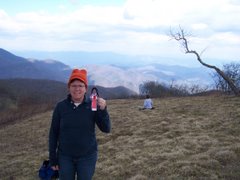Post by Sara Bolen |
| 4 Seasons Hiking Club – First Hike to Sky Meadows State Park |
 |
| Mrs. Bolen with all her knew wisdom! |
Things are on the move here at Blue Ridge Middle School. We had our first 4 Seasons Hiking Club hike to Sky Meadows State Park. It was beautiful weather, about a 5.5 mile hike. We have decided to try to do 4 hikes this year, and they are taking place on the weekends. By having the hikes on the weekends, we are not responsible for providing transportation. Students are also made aware that a parent must hike with them. On our first hike we had about 8 students, each with a parent and about 7 teachers, and 3 dogs join us. We are pictured here at the Paris overlook. The students were great and excited to be there. The parents were in awe of the view; we think we saw Reston/Tyson’s Corner or Washington DC from this vantage point. On the way down, the students were asking when the next hike is going to be.
Little did they know, they next day in PE classes we were starting our orienteering unit. The first and second day of the unit, we went over the parts of a compass and how to use it. We gave the students some worksheets to label the parts of the compass, then in then we gave them time to work with their partners to find particular spots in the gym. On the third day of our unit, we had the students break the speed record for hiking the Appalachian Trail. We finished in 30 minutes! Students were given background information on the trail and we pointed out particular points of interest and access points around us.
Students were then broken into groups and given a pass card with 20 different points along the Appalachian Trail. There were corresponding cones with punches and an exercise to complete throughout the gym. We gave each group a starting point, they explored to find their spot, performed their exercises, punched their pass card and where on their way along the trail. From a teacher standpoint it was really fun listening to groups wondering around the gym “Where is Clingmans Dome, I can’t find it!”, “How do I get to Old Blue Mountain?”
We did not have the cones out in any particular order; they had to explore to find them. When the students completed, we checked their pass cards (formative assessment!).
The next day, students watched a video to help them make a connection with what is around them. We started with pictures from our outdoor classroom and expanded to pictures from our county, then pictures of faculty at Bears Den, Raven Rocks, Jefferson Rocks, Shenandoah River, and Furnace Mountain. The video then goes into the entire trail, how it was developed and who maintains it.
After that, students used posters we had hanging in the gym, they had to write 3 facts about the trail on the back of the card, then come up with a trail name and turn their postcard in to their teacher (another formative assessment!)
As a culminating activity, students participating in an orienteering course set up on our school property. They are given compasses and coordinates. Then they need to navigate to each flag and use the punches to punch their pass card. We borrowed compasses from our high school so we can keep the groups small and each student will have the opportunity to use the compass.
This was a great unit, the students really enjoyed it.














